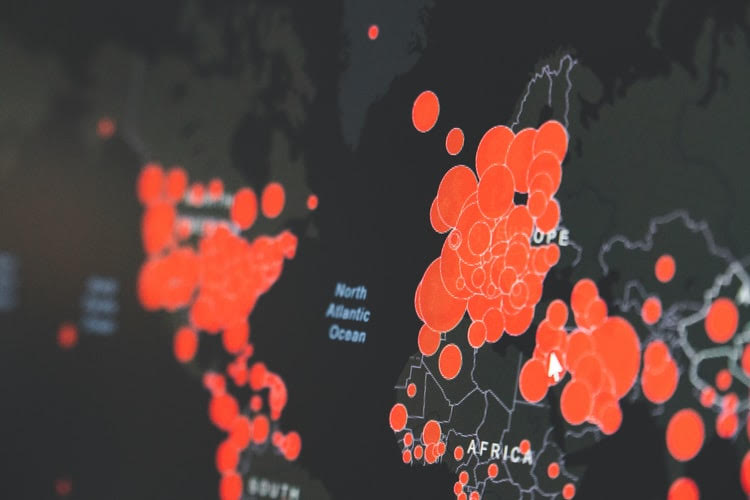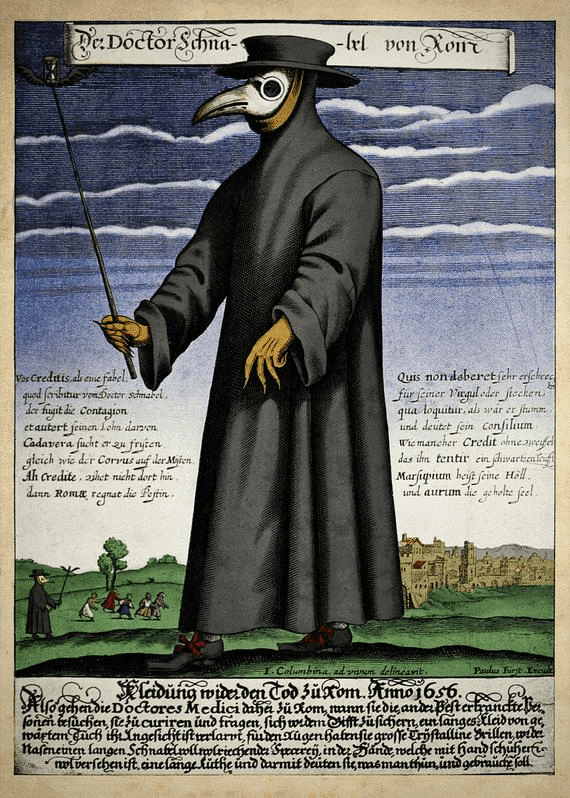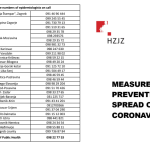March 29, 2020 – A look at the history of pandemics and what we can learn and apply to the current coronavirus pandemic. TCN’s Aco Momcilovic interviews Mirko Sardelic PhD.
Interviewer: Aco Momcilovic, psychologist, EMBA, Owner of FutureHR
Interview with Mirko Sardelic, PhD, Research Associate at the Department of Historical Studies HAZU, Honorary Research Fellow of the ARC Centre of Excellence for the History of Emotions (Europe 1100-1800) at The University of Western Australia; formerly a visiting scholar at the universities of Cambridge, Paris (Sorbonne), Columbia, and Harvard.
Intro: The world is facing one of the biggest global crises of our lifetime. Many individuals are feeling that this is an unprecedented event that will have a major impact on their lives and society. And we are definitely on the verge of a new era; the future will be quite challenging. Therefore, this is a good time to reflect and observe this current situation in the historic context. How much do we know about similar situations, and is there something we can learn and apply to this situation? Some of the answers and comments will hopefully be provided by my friend and history expert – Dr Mirko Sardelic.
Q1: In written history, do we have records of similar pandemics? How many of them were on a comparable level to this Coronavirus situation?
Human history is quite rich when it comes to pandemics. The one we are experiencing today – from what has been known so far (though we must be aware that the pandemic has just started) – may arguably appear as a much milder version of what must have been happening during medieval and early modern plague epidemics. The Justinian plague (541-542 AD) killed millions of people in the Mediterranean zone and beyond. The plague of 1340-50s (known as the Black Death) killed more than 100 million people worldwide, reducing the world’s population by one quarter, and cutting the population of Europe in half. For the next several hundred years deadly outbreaks and epidemics of plague-ravaged helpless humanity in every decade. The last recorded plague in Europe was in 1815. In no time, the first recorded major cholera pandemic started in 1817, and by 1823 had killed millions spreading from India to Southeast Asia and towards Turkey and south Russian lands. There were five major pandemics of cholera in the 19th century alone. In short, every generation has experienced or at least heard of terrible deaths by microbiota. (the Croatian language keeps the phrase used for horribly filthy places one should avoid by all means: ‘kuga i kolera’ – meaning plague and cholera: our folk immortalized the two in this superlative of the adjective ‘filthy’.) Nonetheless, the fact that there were so many horrifying epidemics does not mean we should underestimate this one, as it looks quite serious.
Q2: First scientific data indicates that COVID 19 is more lethal than ‘ordinary’ flu, and estimations of the death rate range between 1 and 3.5% usually. While still counting the number of infected in hundreds of thousands, and the number of dead in tens of thousands, it is clear that numbers are going to be high. But again, it seems that they were nowhere close to the devastating epidemics that raged before. What were the deadliest diseases we had in the past?
What the world knows by the name of Spanish flu (that had very little to do with Spain) infected ca 500 million people – which means almost every third inhabitant of Earth was infected – and it took approximately 50 million lives. One might estimate that the death rate was ca 10%, although this number varied, e.g. some native American communities were almost completely wiped out, most probably because they had never been exposed to similar viruses to which Eurasian populations have acquired some resistance. The Bubonic plague’s death rate was approximately 50% and many contemporary sources claim it was more merciless with younger people. One should, however, bear in mind that the diet, hygiene and overall standard of 14th-century people was quite modest and inadequate, by any contemporary criterion. Very recent Ebola outbreaks had mortality rates ranging from 20 – 70%, but have never developed into a pandemic, due to the nature of the virus that can survive for only a short time outside bodily fluids. It seems that there is often a kind of balance between the contagious and deadly aspect of a virus – but it is epidemiologists who should be explaining this.

Q3: Modern science, and the context of the world in the 21st century, will, fortunately, limit the damage of any disease. It seems that it is very hard for us to imagine the context in which people lived before, without modern medicine, scientists and other tools that we use today. Can you picture that for us?
As the Black Death raged, in October 1348 King Philip VI of France required the medical faculty of the University of Paris to provide an explanation of the plague and its origins. Their response in the Paris Consilium was that the plague had been “caused by a conjunction of the planets Saturn, Jupiter, and Mars at precisely 1:00 pm on 20 March 1345.” In words of a contemporary, Belgian astronomer Simon de Couvin (also called de Covino), who first used the term Black Death: “For Saturn is excessively cold and dry, and as a result is a corrupter of human life”. Once the ‘celestial’ cause was determined, the second step followed: getting rid of the bad air. Ancient scholars Galen and Hippocrates had warned of dangers associated with bad air. It could be the product of swamps, piles of corpses, decaying animals and vegetation, human and animal waste, and stagnant air. Medieval towns had laws against anything that stunk, believing that stink kills. The physicians made a good observation: the dreaded disease transferred through “contagious conversation with other people who have been infected”. Also, objects there were ‘infected’ by the sick were also marked as dangerous.
Imagine this: the Black Death creeps into a town, taking away ca 50% of the population. The only prevention available are staying away from bad air, strict isolation, and prayers. No effective cures are available, even more, no hopes of a non-celestial cure. There is some hope that it would eventually go away though, but there is no reasonable expectation that scientific institutes might come up with vaccines or new-generation drugs. There is no real-time news with epidemiologic advice, no electricity, no running water, no trained medical personnel (in the modern sense), no respirators. On the contrary: there are scarce amounts of food (if any), of light, of heating. Deaths – often quite violent – were omnipresent, even without pandemics. People were cut by sabers of invaders and pirates, factions of social and religious strives carried on brutal executions of their adversaries. In the 16th century, German medical student Felix Platter reports that he rode past a place where “pieces of human flesh hung from the olive trees”. People quite often transposed verbal fights into cutting flesh in duels or violent pub brawls. On top of that, the plague had such disgusting symptoms: the bubonic variant had terribly swollen lymph nodes in the neck and armpits, while the septicemic variant saw its patients vomiting, bleeding from the mouth, nose, and rectum; the extremities got black. All that produced more decaying and more bad air – horror for all senses!
Physicians, surgeons, apothecaries, but also many self-proclaimed healers came up with advice and dozens of remedies, with hundreds of ingredients. In major cities, a stuffed crocodile once hung from the ceiling of best apothecaries in Europe: a symbol that they do something extraordinary and that they have the best-imported ingredients. On the other hand, in the country, the rural folk put more trust in their ‘healers,’ ‘root-wives,’ ‘cunning women’. Most of them had an elementary knowledge of natural processes and wide experience, which meant they could help much in certain matters. Authorities tried to forbid the practice of folk healers – some say it was hard to distinguish between the healer and the witch. Nonetheless, most of these women had an important role as midwives, especially in the times of plague.

Q4: Surprisingly but even today we have anti-vaxxer movements, and other groups who believe in ‘weird’ remedies for illness, like vitamin C or garlic. Is it fair to assume that this way of thinking was standard in the past centuries? What did people then believe it would cure them?
One should have respect for ‘folk’ remedies and prophylactics, such as garlic, lemons (ie. the vitamin C-rich foods), honey, brandies, ginger, and a range of others – as accumulated experience shows they are helpful to an extent. My great-grandmother always mentioned chicken broth as a sort of universal healing concoction. The ancestors taught her that – many generations cooked bone broths. Nutritionists’ analyses showed that those broths rich in calcium, magnesium, collagen, and gelatine are indeed beneficial for some processes in our organism. The tradition has preserved what the collective experience considered as good, and this should be respected. Nonetheless, what should also be very much respected is that there were individuals and groups of scientists who dedicated a lot of their time to research the causes of human illnesses, their treatment, and improvements in the standard of human life. The same is with technology: not only can we indicate the presence of a certain virus/bacterium, but also their size, structure, and weaknesses are known.
You have mentioned the anti-vaxxer movement. As a psychologist, you are well aware of what the fear of the unknown can trigger among people. Emotions are often wonderfully helpful. They direct attention to key features of the environment, optimize sensory intake, tune decision making, prepare behavioural responses, facilitate social interactions, and enhance episodic memory. However, emotions can be quite counterproductive as well, especially when they are of the not-adjusted type, intensity, or duration for a given situation. Because of their nature, vaccines – being fluid with an invisible portion of ‘germs’ that we should rather be exposed to in a controlled environment – might produce fear in some. However, we are also aware that many things that are seemingly invasive help us and save human lives on a daily basis: surgical removals of malign tissue or insertions of coronary stents are just some examples. Fear of death is another tremendously powerful drive: it paralyses reasoning and makes people take otherwise unthinkable actions.
Fear is a mechanism of alerting oneself that the danger is present and that protective measures need to be taken. Fears come in all shapes, sizes (intensities), and durations. Plague (with a good reason) triggered the fear of death, the one that is horrific and that lingers. What were medieval people prepared to do to cure the plague? As one can imagine: everything, literally. One of the most prescribed drugs for preventing and curing the plague was called theriac, the monopoly of which was in hands of Venetian apothecaries. Many variants were known, but it usually took some 60 ingredients and 40 days to process. The key component was roasted viper flesh. ‘Common’ ingredients included honey, the meat of wild beasts, and dried scorpions. Nonetheless, some special ingredients could include nothing less but a ground mummy. And, like good whiskey or rum, the best theriac had to age 12 years. A literary image finds buboes as representations of death literally attached to life. Those would burst on their own in the second week of infection, or the surgeons would drain them.
Surgeons also let blood from their patients, either by incisions on their veins or using leeches which were unpleasant but painless. On their own, the patients tried aromatherapy, eating gems crushed in powder, smeared themselves in in numerous creams, balsams (some of which contained even feces), vinegars, onions, animal parts – no need to elaborate, just use your imagination. One remedy for bubonic plague was quite popular at least from the times of the legendary Islamic physician and philosopher Ibn Sina (in Europe known as Avicenna) from the early 11th century. Live chicken, with some feathers plucked, was held against buboes. It was believed that in this way the chicken would pull the poisons from the buboes into itself. If a chicken died in the process, it had to be replaced with another, which was repeated until one survived the procedure. This ‘live chicken treatment’ was practices for several hundred years, well into the 17th century.
In medieval and early modern Europe doctors knew that there was not a definite cure for the plague, and therefore many of them did not even want to get near the infected. There were priests who refused to give absolution to dying plague victims. This led to the appearance of the plague doctors, hired by cities, and covered in raven-like masks with long beaks. The masks ‘protected’ not only from bad air – which was the heart of disease – but also from the deadly gaze of the dying, which was also feared. For that purpose, there were herbs, spices or vinegar in the beak. These doctors cared for the sick, coordinated the removal of corpses, and registered deaths. One of the most notable was Michel de Nostredame, later called by the Latin variant of the name, Nostradamus – who lost his first wife and both their children to the plague of 1534. Apart from these who could not do much, miracles were expected from St Rocco and St Sebastian, patron saints against the plague.

Q5: After every major event of this kind, there were smaller or bigger shifts in the societies. Usually, it got better in some way. What were the changes after the biggest historical epidemics? What were the economic and political consequences?
Societies learn – or, I would rather say – experience things for themselves. Everyone learns better from one’s own experience. During this pandemic, we will remind ourselves what it means to take prophylactic measures (prevention), how efficient quarantines are, and how (un)disciplined people can be in the times when extreme measures are needed. People are often reckless, which can prove costly. Also, coping with the fear of the unknown can lead to either paralysing effects or, on the other hand, ignoring the threats. This is the moment where experts need to guide and create balance.
Late medieval plagues led to improvements in the way medicine is practised and perceived. ‘Remedies’ provided by alchemists proved to be inefficient, even dangerous and lethal. Mediterranean coastal cities started using lazarettos – specialized complexes of buildings where the quarantine was performed. (The word quarantine came from the Venetian word for the number forty, as that was the number of days after which it was considered safe to bring out goods or people without fear of some latent incubations). The first quarantine was established by the maritime Republic of Dubrovnik (Ragusa) in 1377, as a result of a need for safer continuation of trade.
The 19th-century epidemics caused big leaps in medical science. One of the fathers of epidemiology, English physician John Snow, traced the source of a cholera outbreak in 1854 in London. Cases of chicken cholera and anthrax led Louis Pasteur, French biologist, to promote several life-saving practices in disease prevention. He created the first vaccines for rabies and anthrax, and is credited for many other important discoveries. What was known as the third plague pandemic (that began in Yunnan, China in 1855, and was active till after WWII), that killed dozens of millions of people in China and India alone, attracted bacteriologists who sought after the causes of the disease. In 1894 Swiss-born French Alexandre Yersin and Japanese Shibasaburo Kitasato isolated the bacterium (named after the former, Yersinia pestis). The cause of plague finally got identified.
Therefore, I would say the medical and technological discoveries have made a huge difference. It took humanity thousands of years to learn how to prevent and treat plague; then, starting from the 19th century, it took a century, then decades to make some breakthroughs. The HIV virus took many millions of lives, but it took decades to be put under control. In the 21st century, one may count that vaccines and successful treatments for new diseases will be available within several years, possibly even less, which is a tremendous improvement. One can see the progress in real-time!
As far as the economic consequences are concerned, I am sure that the likes of Joseph Stiglitz experience difficulties when it comes to global prognosis. From a historian’s point of view – in the long-term, humankind recovers, in all its activities – no doubts about that. When it comes to Croatia in the short-term, things could be worrying though. Many things look quite gloomy now: businesses struggle already, and we are not even in the peak of the pandemic; 20% of the GDP is tourism-based; one of the crucial trade partners, Italy, is on her knees, and so on. These challenges will need to be addressed by economists and politicians in the coming months and years. Both short-term and long-term strategies are much needed.
Q6: What was the response of people and rulers/governments during epidemics? What do you think we could use from past experience and implement in today’s way of thinking?
It is important to avoid the negative sides, i.e. abuses in channelling fear. For example, during the Black Death in some Northern European countries, people noticed that Jewish communities (due to their good hygiene practices) had fewer deaths than others. This led to antisemitic movements in some countries; many Jews were persecuted, even massacred, in spite of the efforts of Pope Clement VI who tried to protect the Jews against allegations that they had their hands in the plague outbreak. In our times many Chinese must have experienced quite unpleasant situations. As far as rulers and governments are concerned, history does record protective measures concerning the economy, public health and safety. On the other hand, again, there have always been (more or less successful) attempts of rulers to seize more power – as extreme situations require extreme measures. We should all be aware of what happens to our civic freedoms during, and especially after, the pandemics. Even more importantly, we all need to do our best to keep the fear down. History has shown that unleashed fear can sometimes be as dangerous as the initial danger itself.
In my opinion, one thing is for sure: there are no limits. The dimension of viruses is measured in nanometres (10-9), while the distance from Earth to Sun, for example, is measured in gigametres (109). There are so many worlds in-between these 18 powers of scale, and this is not even half of the spectrum. The same is with history – history has seen pretty much everything: millions of years, the evolution of animals and societies; projects that fell victim to greed, fear or egoism; achievements that were built on hope, bravery, enthusiasm, joint efforts. History can teach a lot, but often, for various reasons, it does not put its lessons into full effect. Maybe this is because it’s huge and inert, while our brains prefer swift stimuli, quick(er) solutions, and palpable outcomes. Nonetheless, one important lesson is that nothing is impossible, and that things can go in uncountable directions. They have led us this far, to this scenario, out of gazillion possible ones, (among other factors) thanks to people who invested their time, resources, and lives into making our existence enjoyable, interesting, and way safer than they have ever been.
An ordinary human couple experiences everyday struggles in decision-making, let alone those of societies. Generally, most of them want to be healthy, enjoy personal freedom and experience economic prosperity. We have seen that humans can achieve pretty much anything they want. There are just two questions (to start with): At which rate? And at what cost? There were some ethical dilemmas behind the curtain: should one ‘sacrifice’ the lives of the old and immunocompromised (who are the most likely victims of the present pandemic) in order to recover the economy more quickly? The pros were suggesting that the damaged economy would lead in numerous job cuts, which again leads to poverty, depression, ‘killing-us-slowly’ scenarios. On the other hand, what can be more human than taking care of the most vulnerable members of our society: the young, the elderly, the sick, the fragile? These are the times when solidarity, unselfishness, and caring come in.
Finally, can it be done respecting the equilibrium of our eco-system? Let us not forget: humans are unique eco-systems as well: our viruses, bacteria, and fungi live in our cells, in our gut, on our skin. Their number is measured in trillions (a million millions). We might have affected them significantly, but it is still hard to say what would be the long-term result of tampering with what has undergone millions of adaptations, millions of mutations. Exposure to some viruses resulted in some of the most fascinating animal and human mutations, and evolutions. The story of humans and viruses continues: we have gone through so much together.
For the latest on coronavirus in Croatia, visit the dedicated TCN section.









